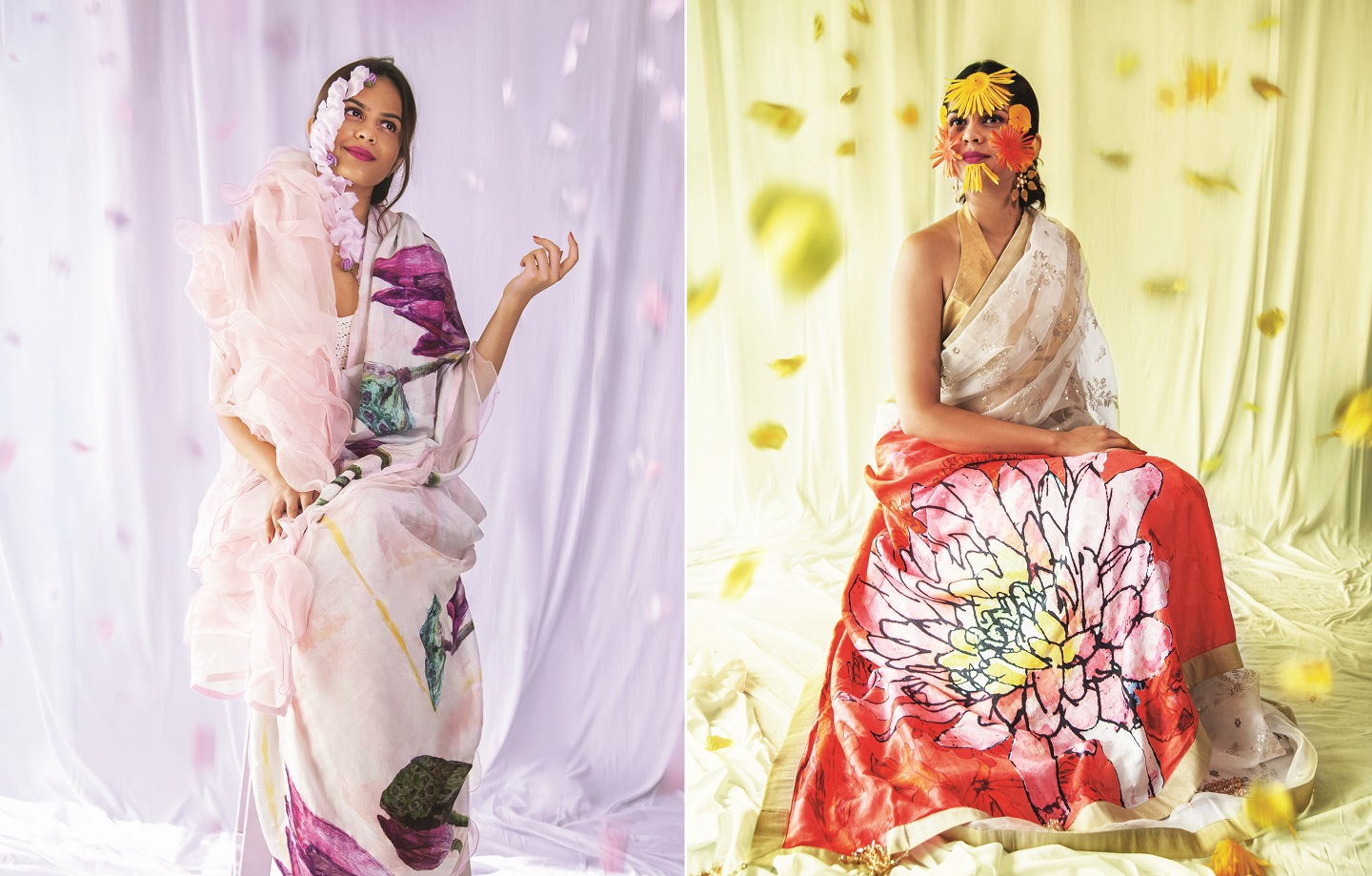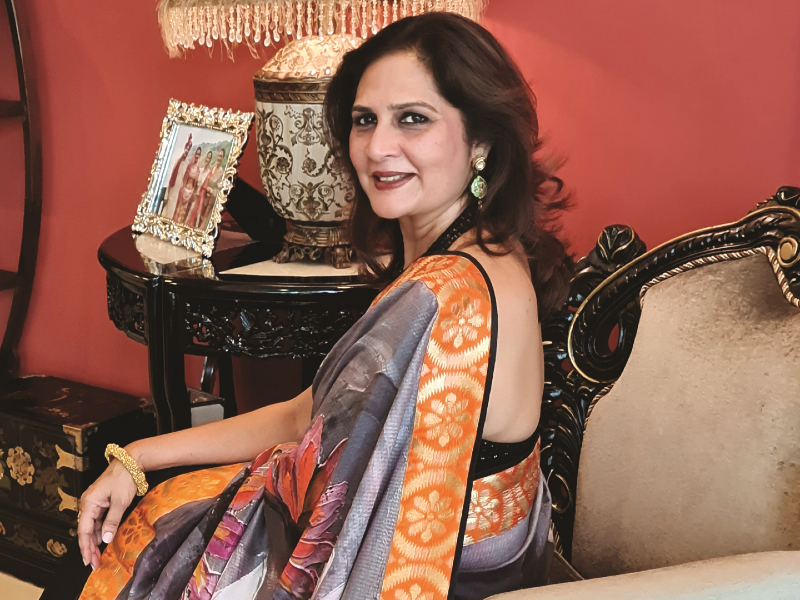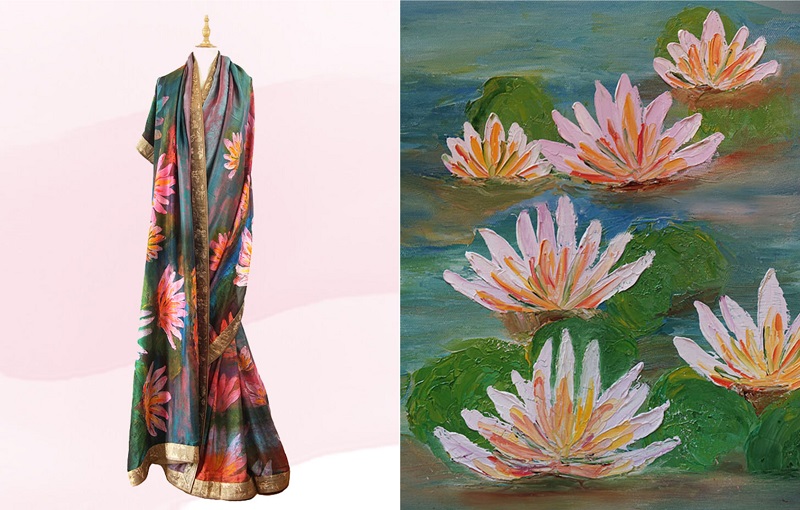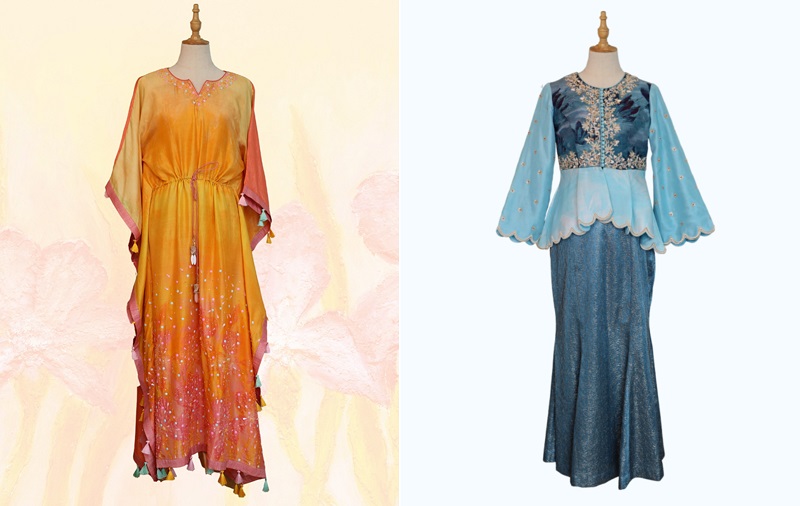
The Nesya (left) and Abha sarees feature watercolour flowers by Miranda Free (All photos: Kimkara)
Fashion is definitely an artform and, at the very least, requires an artistic eye. However, the ways in which art and fashion are presented are very different. The former is displayed in galleries on walls or podiums, while the latter is worn by models for photo shoots or to strut down runways. Hanging up and gazing at your favourite painting and wearing a designer gown are very different experiences. But what if the thoughtful brushstrokes and designs on the canvas can be translated into something wearable?
This was the intention behind Shikha Grover’s debut collection of sarees titled Bodh. The range featured paintings by Grover’s then business partner Deepika Gupta and, while their creations were made to be worn, they were presented like works of art. “We did a beautiful exhibition at Ilham Gallery, and everybody loved it because we hung these sarees from the ceiling and they looked like paintings. Imagine 75 pieces, each one different,” she says.
The lead-up to this successful exhibition in Kuala Lumpur required mountains of research and development. “We went to Benares (an industrial centre in India famous for its muslin and silk fabrics, among others) and wanted to do something with sarees and art. We asked the weavers, can you translate [Deepika’s] paintings on sarees, and they said yes … it would take six months to make one piece. That didn’t work for us, so we delved into different areas when we went back to Delhi, and found digital printing,” Grover explains.
shikha3_1.jpg

She was determined that her creations would not just be simple prints but, rather, vibrant works that look like they have been painted by hand. It took three years of careful experimentation with fabrics and printing techniques to bring Bodh to life.
Following the Ilham exhibition, Grover began her own luxury fashion label, Kimkara, in 2018. Her designs are based on artists’ paintings, which she reinterprets for clothing such as sarees, kaftans and jackets. Each artist has a distinct style — self-styled Dr Jatinder S Bhogal’s works are inspired by Indian mythology and folklore; Australia-based Miranda Free’s botanical artworks use mediums like watercolour and alcohol ink; and Upasana Mishra’s multi-disciplinary pieces, featured in the range launched last December, boast three-dimensional strokes created by using ceramic art on canvas.
Kimkara’s outfits have almost three layers of artistic creation and influence. The first is from the artist itself. The second is Grover’s wizardry with Photoshop and other computer programs to translate elements of the paintings onto her outfits. She plays with colour, placement and textures, while maintaining the artistic voice from the original work. The final layer often comes from customers themselves, which is the bespoke element of Kimkara. Customers sometimes request a colour tweak or a change in size, and Grover is often ready to accommodate.
kimkara_dazzling_lily.jpg

“I don’t have a fashion background, so I needed somebody who knew how to work with the tailors in Bombay, for example. My daughter’s very close friend, who was running her own boutique in Bombay, said, ‘Auntie, I’d love to do it’. Her name is Aruna Jain and she came into the picture with Bodh. She is pretty amazing because we brainstorm and I take one month off and go to Bombay and we go to markets together,” she says.
These markets are where the two source premium Lucknowi fabrics and high-quality accessories such as tassels to complete their designs.
Made using rich organic silks, Kimkara’s prices range from RM1,500 to RM3,000. While the sarees are exclusive one-off pieces, kaftans and tunics come in five to six pieces each. All of Grover’s designs are made to order.
Grover’s diverse background has taught her so much that she can apply to this venture. Born in Bombay, India, she studied mathematics and science. She married at a young age and because of her husband’s work, moved very often, with each city bringing her new knowledge. “In Benares, I ventured into buying sarees. I bought them for a lot of people, so I knew the different fabrics, how the trade of sarees happened and how the weavers weaved their silks. I got very interested in that.”
However, Grover was suddenly diagnosed with multiple sclerosis, which led to a complete change in her lifestyle. “I decided to fight it, and changed my whole thinking and attitude towards the disease. As I was recovering, since I couldn’t take up hectic work, I decided to go back to education. I did two management degrees in education and HR back-to-back,” she explains.
Grover then began working with Childline India Foundation, and was there for 10 years. “Every problem seemed small in terms of when you look at what kinds of problems really exist in the world. I could see the street children, and people fighting much bigger issues and still smiling through it and being happy. So, my whole definition of happiness changed. It was really the best part of my life,” she adds. From then on, she ate healthy, got fit, worked and watched her two daughters grow.
Kuala Lumpur was her husband’s first international posting, and it meant leaving her job and starting from scratch. She was keen to continue in social work and volunteered with Voice of the Children. Grover decided she wanted to make a real difference, even if it meant impacting only one person. She was asked to shadow a student in Garden International School who had trouble with her eyesight. It was a rewarding challenge, and Grover helped the student complete her O-levels. It was soon after this that the stirrings of Bodh and the inception of Kimkara began.
kimkara_raya.jpg

Encouraged and supported by dancer-choreographer Datuk Ramli Ibrahim and fashion designer Gillian Hung, Grover has decided to create a Raya collection. She studied different styles of baju and delved into the world of Malaysian traditional wear. “In February, I was designing. This month, we went into production, and next month, we are launching,” she says.
The KitaRayaKita collection is a fusion of sorts and includes art by Mishra. “While the art does take centre stage, the embellishments have to do something more. So, I have played around with this whole idea and given it tones of light and dark, so most of the designs have dual tones. Like, the baju would have a lighter sleeve of the art while the front is embellished. So, it’s like two artworks happening,” Grover explains.
The collection includes five styles of baju and five kaftans, all suitable for Raya wear. All the embroidery and embellishments added to these pieces are done by hand. Having seen some of Kimkara’s previous works in person, I have no doubt that each design element will be thoughtfully placed and crafted to the highest quality. For the new collection, customers can look forward to a playful mix of cultural elements. For instance, Grover mentions that she has tried her hand at a few baju kurung styles, and one of the skirts even includes pleats, giving it that saree feel. “It’s an Indian approach, to match Malaysian sensibilities,” she adds.
This article first appeared on Mar 29, 2021 in The Edge Malaysia.


